Abstract
The metabolism of glucose and glutamine in freshly prepared resting and concanavalin A-stimulated rat thymocytes was studied. Concanavalin A addition enhanced uptake of both glucose and glutamine and led to an increase in oxidative degradation of both substrates to CO2. With variously labelled [14C]glucose, it was shown that the pathways of glucose dissimilation were equally stimulated by the mitogen. A disproportionately large percentage of the extra glucose taken up was converted into lactate, but concanavalin A also caused an increase in the oxidation of pyruvate as judged by the enhanced release of 14CO2 from [2-14C]-, [3,4-14C]- and [6-14C]-glucose. Addition of glutamine did not affect glucose metabolism. The major end products of glutamine metabolism by resting and mitogen-stimulated rat thymocytes were glutamate, aspartate, CO2 and NH3. Virtually no lactate was formed from glutamine. Concanavalin A enhanced the formation of all end products except glutamate, indicating that more glutamine was metabolized beyond the stage of glutamate in the mitogen-activated cells. Addition of glucose caused a significant decrease in the rates of glutamine utilization and conversion into aspartate and CO2 in the absence and in the presence of concanavalin A. In the presence of glucose, almost all nitrogen of the metabolized glutamine was accounted for as NH3 released via the glutaminase and/or glutamate dehydrogenase reactions. In the absence of glucose, part (18%) of the glutamine nitrogen was metabolized by the resting and to a larger extent (38%) by the mitogen-stimulated thymocytes via a transaminase or amidotransferase reaction.
Full text
PDF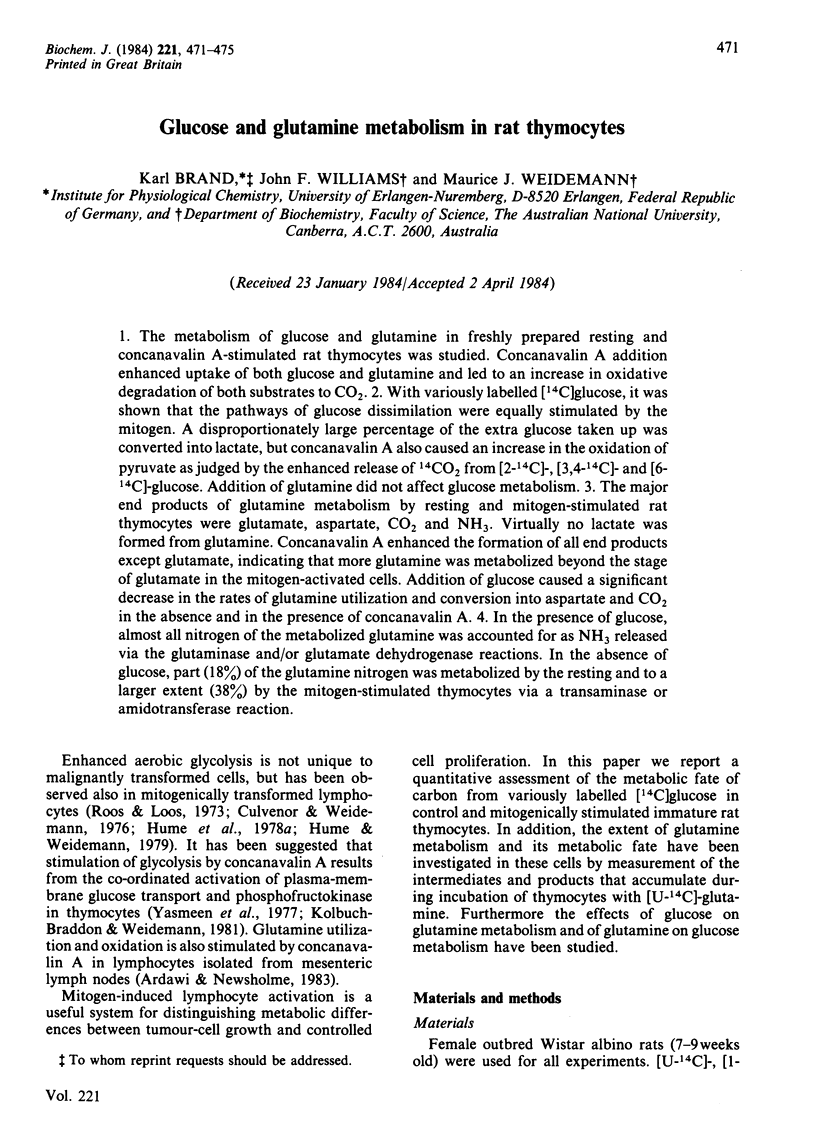
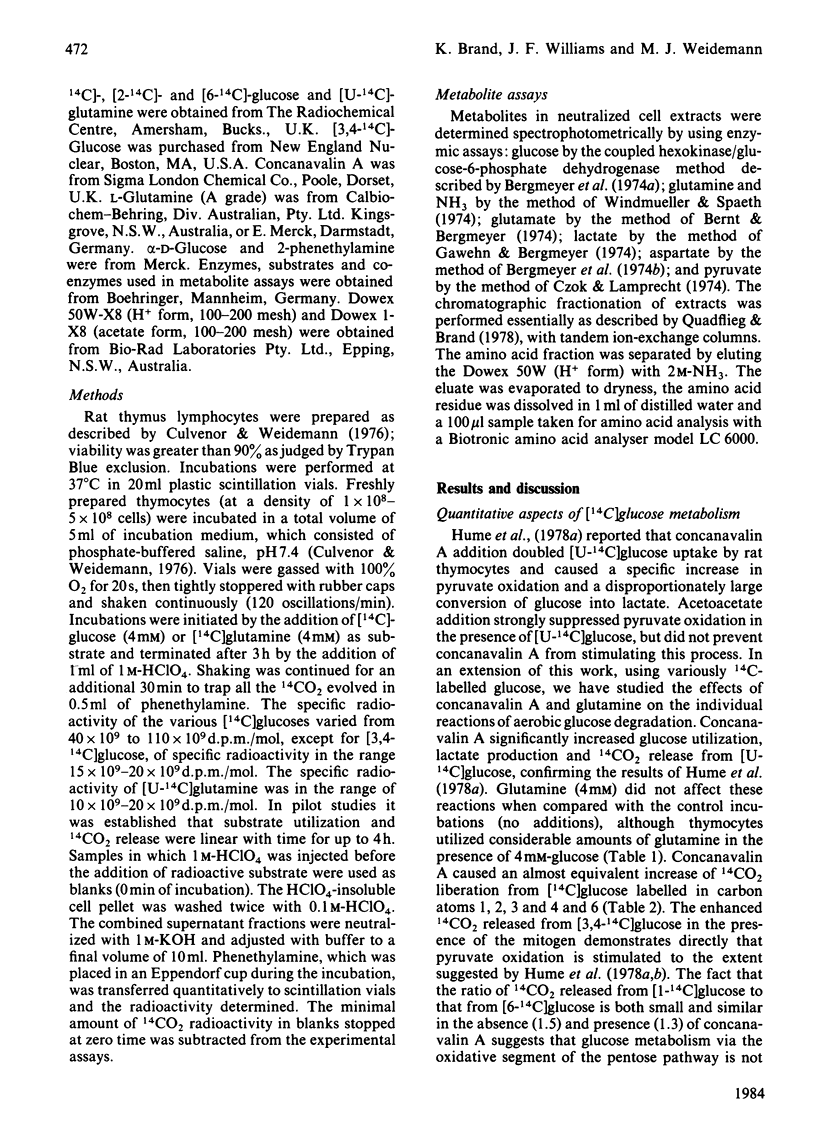
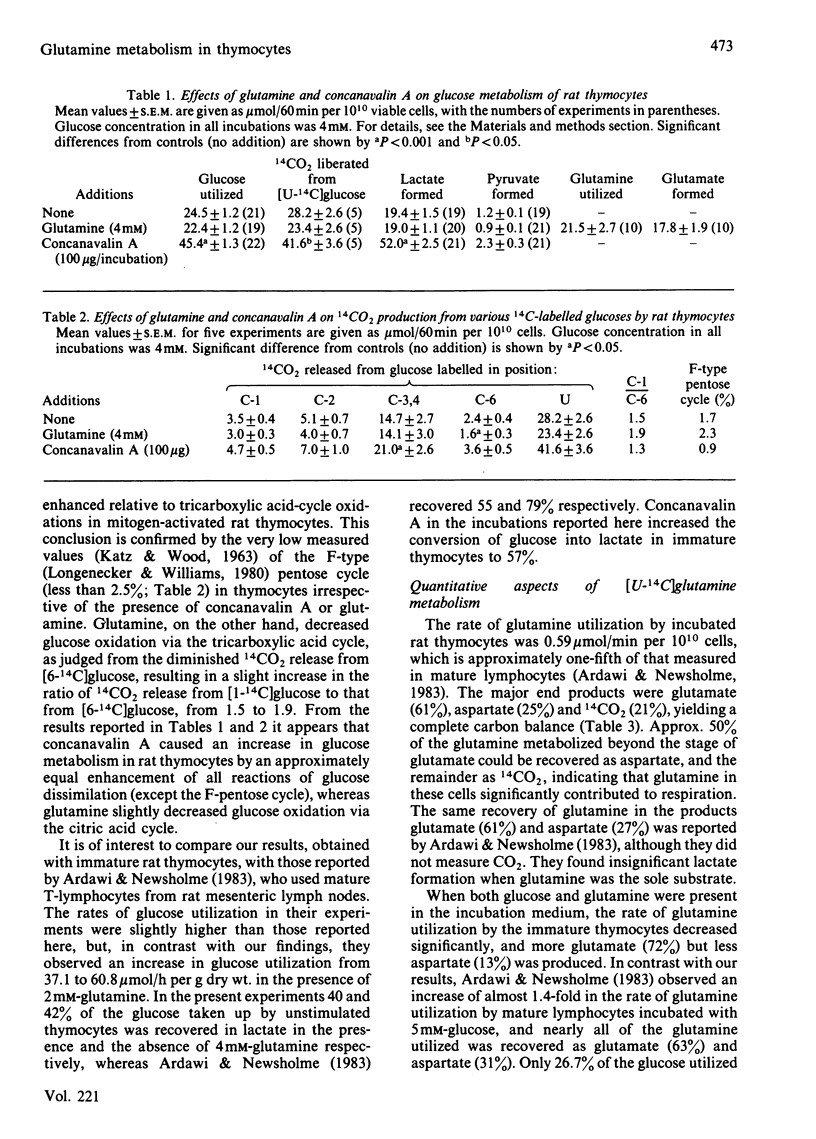
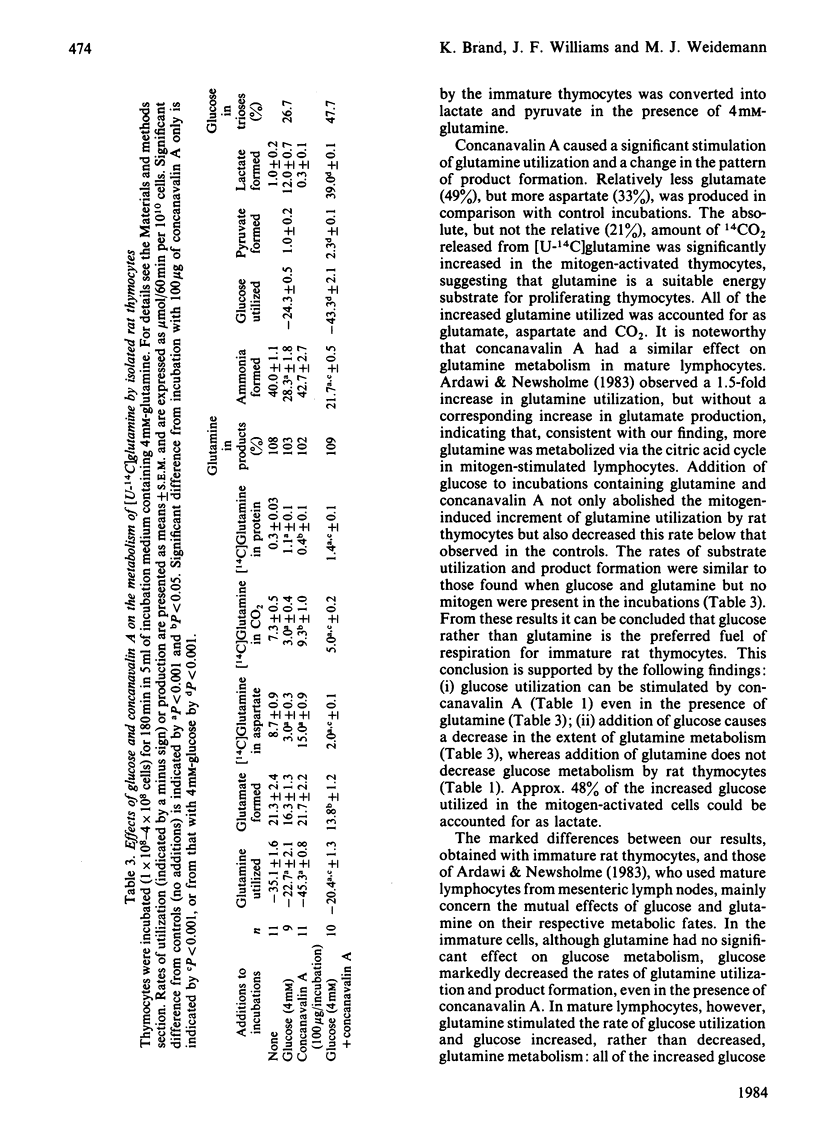
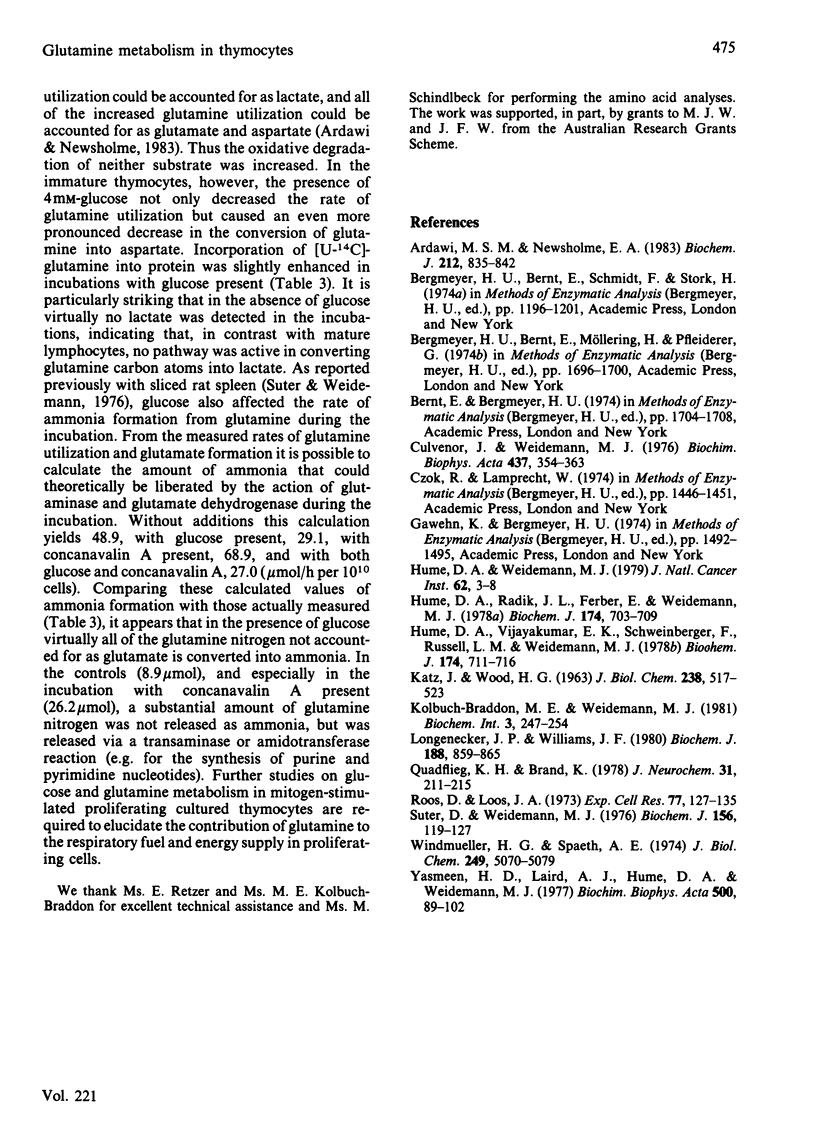
Selected References
These references are in PubMed. This may not be the complete list of references from this article.
- Ardawi M. S., Newsholme E. A. Glutamine metabolism in lymphocytes of the rat. Biochem J. 1983 Jun 15;212(3):835–842. doi: 10.1042/bj2120835. [DOI] [PMC free article] [PubMed] [Google Scholar]
- Culvenor J. G., Weidemann M. J. Phytohaemagglutinin stimulation of rat thymus lymphocytes glycolysis. Biochim Biophys Acta. 1976 Jul 21;437(2):354–363. doi: 10.1016/0304-4165(76)90005-2. [DOI] [PubMed] [Google Scholar]
- Hume D. A., Radik J. L., Ferber E., Weidemann M. J. Aerobic glycolysis and lymphocyte transformation. Biochem J. 1978 Sep 15;174(3):703–709. doi: 10.1042/bj1740703. [DOI] [PMC free article] [PubMed] [Google Scholar]
- Hume D. A., Vijayakumar E. K., Schweinberger F., Russell L. M., Weidemann M. J. The role of calcium ions in the regulation of rat thymocyte pyruvate oxidation by mitogens. Biochem J. 1978 Sep 15;174(3):711–716. doi: 10.1042/bj1740711. [DOI] [PMC free article] [PubMed] [Google Scholar]
- Hume D. A., Weidemann M. J. Role and regulation of glucose metabolism in proliferating cells. J Natl Cancer Inst. 1979 Jan;62(1):3–8. [PubMed] [Google Scholar]
- KATZ J., WOOD H. G. The use of C14O2 yields from glucose-1- and -6-C14 for the evaluation of the pathways of glucose metabolism. J Biol Chem. 1963 Feb;238:517–523. [PubMed] [Google Scholar]
- Longenecker J. P., Williams J. F. Quantitative measurement of the L-type pentose phosphate cycle with [2-14C]glucose and [5-14C]glucose in isolated hepatocytes. Biochem J. 1980 Jun 15;188(3):859–865. doi: 10.1042/bj1880859. [DOI] [PMC free article] [PubMed] [Google Scholar]
- Quadflieg K. H., Brand K. Time-dependent partitioning of glucose carbons metabolized by the superior cervical ganglion from calves. J Neurochem. 1978 Jul;31(1):211–215. doi: 10.1111/j.1471-4159.1978.tb12450.x. [DOI] [PubMed] [Google Scholar]
- Roos D., Loos J. A. Changes in the carbohydrate metabolism of mitogenically stimulated human peripheral lymphocytes. II. Relative importance of glycolysis and oxidative phosphorylation on phytohaemagglutinin stimulation. Exp Cell Res. 1973 Mar 15;77(1):127–135. doi: 10.1016/0014-4827(73)90561-2. [DOI] [PubMed] [Google Scholar]
- Suter D., Weidemann M. J. Regulation of carbohydrate metabolism in lymphoid tissue. Nature of the endogenous substrates and their contribution to the respiratory fuel of the sliced rat spleen in vitro. Biochem J. 1976 Apr 15;156(1):119–127. doi: 10.1042/bj1560119. [DOI] [PMC free article] [PubMed] [Google Scholar]
- Windmueller H. G., Spaeth A. E. Uptake and metabolism of plasma glutamine by the small intestine. J Biol Chem. 1974 Aug 25;249(16):5070–5079. [PubMed] [Google Scholar]
- Yasmeen D., Laird A. J., Hume D. A., Weidemann M. J. Activation of 3-O-methyl-glucose transport in rat thymus lymphocytes by concanavalin A. Temperature and calcium ion dependence and sensitivity to puromycin but to cycloheximide. Biochim Biophys Acta. 1977 Nov 7;500(1):89–102. doi: 10.1016/0304-4165(77)90049-6. [DOI] [PubMed] [Google Scholar]


